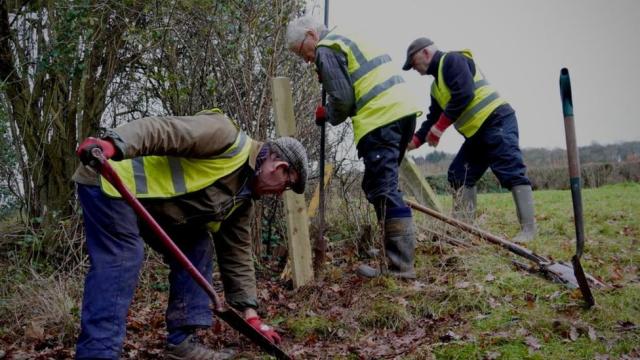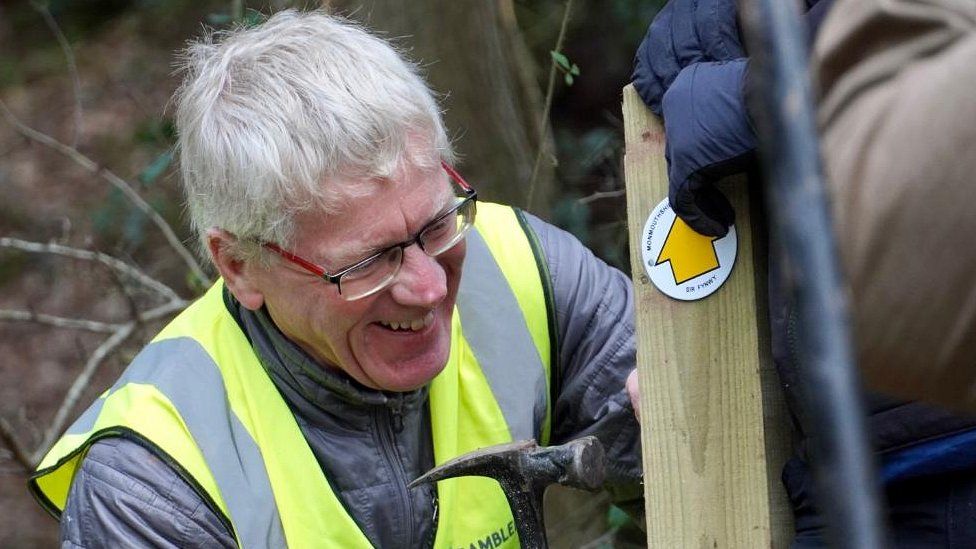Public rights of way blocked in 32,000 places

Walkers wanting to enjoy footpaths across the British countryside are being blocked or obstructed in nearly 32,000 places across England and Wales.
But they are fighting back, with one rambler even training as a lawyer to force councils to keep the way clear.
A BBC investigation found councils which have responsibility for footpaths had 4,000 more access issues on public rights of way in 2023 than in 2022.
Campaigners said this showed a “growing abuse and neglect” of the path network.
Local authorities said “funding constraints” limited what they can do.
In Cornwall, which has 2,796 miles (4,500km) of public rights of way, Lucy Wilson is one walker determined to make sure countryside footpaths are kept useable.

Standing on a footpath tucked into the folds of the Tamar Valley, Mrs Wilson points up at a sheer muddy bank, topped with a thicket of brambles.
“That’s where the path should go,” she says. “You can’t see anything. It’s just gone.”
Her finger traces the registered right of way on a map on her phone. We scramble up the bank but have no chance of forcing our way past the thorns.
She explains that people have been trying for five years to get Cornwall Council to make this path accessible.
“The council doesn’t have the resources – but that’s not an excuse, because they have a statutory duty to do this. It’s not a choice,” she explains.
All landowners have a duty to keep paths clear but the ultimate responsibility rests with the local highways authority – usually the local county or unitary council or national park authority.
‘Shocking neglect’
Mrs Wilson, a campaigner with the Open Spaces Society, estimates that half of the Cornish footpath network has unresolved issues.
She began her fight to get paths cleared in 2015 and is now training as a lawyer to try to force the council to act.
“I was trying to enjoy the countryside, and I found on quite a few occasions, I couldn’t because there were gates locked, they were overgrown, impossible to get through.
“I thought rather naively, that just reporting the obstructions to the council, the council would come along and clear them. And it didn’t happen. And so here I am in 2023, some of those same paths remain obstructed,” she said.
Cornwall Council said that it was “committed to protecting the public rights of way across Cornwall”.
“Each case is determined on its own merits and we will consider the best course of action to ensure any obstructions are removed.
“The council has a finite resource and must prioritise workload accordingly,” a spokesperson explained.

Meanwhile, across England and Wales, The Ramblers – Britain’s walking charity – say they are coming across similar problems – but the true scale of blocked and obstructed footpaths has so far remained unknown.
So the BBC used Environmental Information Regulations to ask 118 local councils outside of London and national park authorities how many blockages and obstructions were recorded at the end of 2022 and on a specific day – 31 October 2023.
Seventy-three authorities were able to provide the data, with 31,816 obstructions – ranging from overgrown vegetation to deliberately fenced-off paths – recorded on 31 October, an increase from 27,696 at the end of 2022.
Kate Ashbrook, general secretary of the Open Spaces Society, said the results of the BBC’s investigation showed “a shocking and growing abuse and neglect of our public path network”.
She added that local authorities were “failing to carry out their legal duties to assert and protect the public’s rights to enjoy these public highways”.
Jack Cornish, head of paths for The Ramblers, said obstructions and blockages were a common issue “but we are shocked to learn quite how many of these issues on paths remain unresolved”.
“In fact, we suspect there are vastly more blockages and obstructions than the figures show, because our own research shows that the public don’t know how, or where, to report issues they experience on paths,” he added.
The councils themselves say “funding constraints” limit the amount of footpath maintenance they can do.
“Long-term, consistent funding would help councils plan ahead for maintenance and to reduce obstructions on rights of way,” said Darren Rodwell, transport spokesperson for the Local Government Association.
The UK government said English councils’ funding settlement for 2024/25 is more than £64bn and they were “best placed to decide how this funding is spent, including on maintaining the public paths network”.
But the government is also working with landowners themselves – last week it announced new funding incentives would be on offer to farmers next year to create, maintain and upgrade footpaths.
Environment secretary Steve Barclay said: “The best way of unblocking issues is to get the landowners on board to work in partnership which in turn is great for the public but is good as a whole in terms of the country’s health and wider wellbeing.”

In Wales, the government said it was funding a three-year £5.6m grant to help councils and national park authorities improve and maintain public rights of way.
One of those councils is Monmouthshire County Council, which is leading the way in working with landowners and walkers to protect and repair footpaths.
It also works with volunteer groups of walkers to ensure problems are reported to its online mapping system as soon as possible.
As a result, it received more than 15,000 reports of issues last year but says it only has 181 ‘live’ footpath problems that it currently has to deal with on its 1,031-mile (1,659km) network
We met Andrew Stumpf, a volunteer with The Ramblers Cymru, in Grosmont.
He leads a group of fellow local walkers as they stomp through a boggy field, shoulders heavy with spades, and a wooden post.
They are off to replace a rotten waymarker, with the landowners’ permission.
The kit and training is paid for by Monmouthshire County Council; the volunteers provide the labour.
“They supply us with the materials and the training expertise,” explains Mr Stumpf. “And they come out and help us to do the more complicated stuff. It means from their perspective that it’s being done to the right standard.
“It works for us, because we’re doing healthy activity, and we’re getting more paths that we can actually enjoy.”











